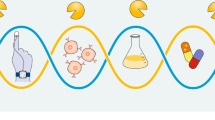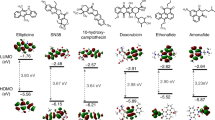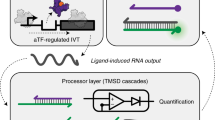Abstract
Naphthalene diimide (NDI) is an electron-deficient, robust, and planar molecule. These characteristics make it highly applicable to electronic devices that take advantage of their electric character, for imide group-based supramolecular materials that utilize hydrogen bonding, or for sensing materials with a combination of functional groups. Water-soluble NDI binds to a DNA duplex via the threading intercalation mode. Such NDI has enabled the development of unique DNA analytical techniques, functional DNA polymers, and supramolecular polymers. A ferrocene-containing NDI, possessing electrochemically active sites, has been applied to an electrochemical gene detection system and utilized in the precision analysis of genes and single nucleotide polymorphisms. Recently, a DNA quadruplex was identified as one of the noncanonical DNA structures formed by a guanine quartet (G4). The latter serves as one of the control units of gene expression and is associated with cancer development. A stable complex was formed between electron-deficient NDI and the electron-rich G4 planes. Since the G4 stabilizer is recognized as an anticancer agent with relatively few side effects, NDI derivatives may serve as potential candidates for anticancer therapeutics or for designing a unique cancer-detection system.
This is a preview of subscription content, access via your institution
Access options
Subscribe to this journal
Receive 12 print issues and online access
$259.00 per year
only $21.58 per issue
Buy this article
- Purchase on Springer Link
- Instant access to full article PDF
Prices may be subject to local taxes which are calculated during checkout








Similar content being viewed by others
References
Bhosale SV, Jani CH, Langford SJ. Chemistry of naphthalene diimides. Chem Soc Rev. 2008;37:331–42.
Kobaisi MA, Bhosale SV, Latham K, Raynor AM, Bhosale SV. Functional naphthalene diimides: synthesis, properties, and applications. Chem Rev. 2016;116:11685–796.
Das A, Ghosh S. H-bonding directed programmed supramolecular assembly of naphthalene-diimide (NDI) derivatives. Chem Commun. 2016;52:6860–72.
Yen SF, Gabbay EJ, Wilson WD. Interaction of aromatic imides with deoxyribonucleic acid. Spectrophotometric and viscometric studies. Biochemistry. 1982;21:2070–6.
Tanious FA, Yen S-F, Wilson WD. Kinetic and equilibrium analysis of a threading intercalation mode: DNA sequence and ion effects. Biochemistry. 1991;30:1813–9.
Ou T, Lu Y, Tan J, Huang Z, Wong KY, Gu L. G-Quadruplexes: targets in anticancer drug design. ChemMedChem. 2008;3:690–713.
Yang D, Okanoto K. Structural insights into G-quadruplexes: towards new anticancer drugs. Future Med Chem. 2010;2:619–46.
Pirota V, Nadai M, Doria F, Richter S. Naphthalene diimides as multimodal G-quadruplex-selective ligands. Molecules. 2019;24:426.
Gawronski J, Brzostowska M, Kacprzak K, Kolbon H, Skowronek P. Chirality of aromatic bis-imides from their circular dichroism spectra. Chirality. 2000;12:263–8.
Green S, Fox A. Intramolecular photoinduced electron transfer from nitroxyl radicals. J Phys Chem. 1995;99:14752–7.
Salerno F, Berrocal JA, Haedler AT, Zinna F, Meijer EW, Bari LD. Highly circularly polarized broad-band emission from chiral naphthalene diimide-based supramolecular aggregates. J Mater Chem C. 2017;5:3609–15.
Andric G, Boas JF, Bond AM, Fallon GD, Ghiggino KP, Hogan CF et al. Spectroscopy of naphthalene diimides and their anion radicals. Aut J Chem. 2004;57:1011–9.
Chu Y, Hoffman DW, Iverson BL. A pseudocatenane structure formed between DNA and A cyclic bisintercalator. J Am Chem Soc. 2009;131:3499–508.
McGhee JD, von Hippel PH. Theorical aspects of DNA-protyein interaction: co-operative and non-co-operative binding of large ligands to a one-dimensional homogeneous lattice. J Mol Biol. 1974;86:469–89.
McKnight RE, Gleason AB, Keyes JA, Sahabi S. Binding mode and affinity studies of DNA-binding agents using topoisomerase I DNA unwinding assay. Bioorg Med Chem Lett.2007;17:1013–7.
Wilson WD, Jones RL. Intercalation in biological systems. Intercalation Chemistry, Whittingham MS, Jacobson AJ, editors. New York: Academic Press; 1982, pp. 445–510.
Takenaka S, Yamashita K, Takagi M, Uto Y, Kondo H. DNA sensing on a DNA probe-modified electrode using ferrocenylnaphthalene diimide as the electrochemically active ligand. Anal Chem. 2000;72:1334–41.
Yamashita K, Takagi M, Kondo H, Takenaka S. Electrochemical detection of nucleic base mismatches with ferrocenyl naphthalene diimide. Anal Biochem. 2002;306:188–96.
Miyahara H, Yamashita K, Kanai M, Uchida K, Takagi M, Kondo H et al. Electrochemical analysis of single nucleotide polymorphisms of p53 gene. Talanta. 2002;56:829–35.
Nojima T, Yamashita K, Takagi A, Takagi M, Ikeda Y, Kondo H et al. Electrochemical analysis of single nucleotide polymorphisms of p53 gene. Anal Sci. 2003;19:79–83.
Nojima T, Yamashita K, Takagi A, Ikeda Y, Kondo H, Takenaka S. Genotyping of human lipoprotein lipase gene by ferrocenylnaphthalene diimide-based electrochemical hybridization assay. Anal Sci. 2005;21:1437–41.
Sato S, Hokazono K, Irie T, Ueki T, Waki M, Nojima T et al. Ferrocenylnaphthalene diimide-based electrochemical detection of methylated gene. Anal Chim Acta. 2006;578:82–7.
Ishikawa N, Miya T, Mizumoto K, Ohuchida K, Nagai E, Yamaguchi K et al. Rapid and sensitive assay of K-ras mutations in pancreatic cancer by electrochemical detection with ferrocenyl-naphthalene-diimide. Cancer Genomics Proteom. 2006;3:47–54.
Sato S, Tsueda M, Kanezaki Y, Takenaka S. Detection of an aberrant methylation of CDH4 gene in PCR product by ferrocenylnaphthalene diimide-based electrochemical hybridization assay. Anal Chim Acta. 2012;715:42–8.
Harahuchi K, Sato S, Habu M, Yada N, Hayakawa M, Takahashi O et al. Oral cancer screening based on methylation frequency detection in hTERT gene using electrochemical hybridization assay via a multi-electrode chip coupled with ferrocenylnaphthalene diimide. Electroanalysis. 2017;29:1596–601.
Sato S, Saeki T, Tanaka T, Kanezaki Y, Hayakawa M, Haraguchi K et al. Ferrocenylnaphthalene diimide-based electrochemical detection of aberrant methylation in hTERT gene. Appl Biochem Biotechnol. 2014;174:869–79.
Sato S, Takenaka S. Linker effect of ferrocenylnaphthalene diimide ligands in the interaction with double stranded DNA. J Organomet Chem. 2008;693:1177–85.
Sato S, Tsueda M, Takenaka S. Electrochemical detection of aberrant methylated gene using naphthalene diimide derivative carrying four ferrocene moieties. J Origanomet Chem. 2010;695:1858–62.
Sato S, Nojima T, Waki M, Takenaka S. Supramolecular complex formation by β-cyclodextrin and ferrocenylnaphthalene diimide-intercalated double stranded DNA and improved electrochemical gene detection. Molecules. 2005;10:693–707.
Sato S, Nojima T, Takenaka S. Electrochemical gene detection based on supramolecular complex formation by ferrocenyl-b-cyclodextrin and adamantylnaphthalene diimide bound to double stranded DNA. J Organomet Chem. 2004;689:4722–8.
Takenaka H, Sato S, Takenaka S. Electrochemical detection of duplex DNA using intercalation-triggered decomplexation of ferrocene with b-cyclodextrin. Electroanalysis. 2013;25:1827–30.
Watanabe S, Sato S, Ohsuka K, Takenaka S. Electrochemical DNA analysis with a supramolecular assembly of naphthalene diimide, ferrocene, and β-cyclodextrin. Anal Chem. 2011;83:7290–6.
Komizo K, Ikeda H, Sato S, Takenaka S. Metallization of double-stranded DNA triggered by bound galactose-modified naphthalene diimide. Bioconjugate Chem. 2014;25:1547–55.
Ohtsuka K, Komizo K, Takenaka S. Synthesis and DNA binding behavior of a naphthalene diimide derivative carrying two dicobalt hexacarbonyl complexes as an infrared DNA probe. J Organomet Chem. 2010;695:1281–6.
Himuro T, Araki R, Sato S, Takenaka S, Yasuda T. Specific metallization of double-stranded DNA using reducing group-labeled intercalator. IEEJ Trans Sens Micromachines. 2016;36:425–31.
Sato S, Umeda Y, Fujii S, Takenaka S. Cooperative binding of ferrocenylnaphthalene diimide carrying β-cyclodextrin converts double-stranded DNA to a rod-like structure. Bioconjugate Chem. 2015;26:379–82.
Steel AB, Heme TM, Tarlov MJ. Electrochemical quantitation of DNA immobilized on gold. Anal Chem. 1998;70:4670–7.
Sato S, Hirano A, Takenaka S. Selective immobilization of double stranded DNA on a gold surface through threading intercalation of a naphthalene diimide having dithiolane moieties. Anal Chim Acta. 2010;665:91–97.
Sato S, Yamamura K, Takenaka S. Naphthalene diimide carrying two cysteine termini at both imide linkers as a molecular staple. Electroanalysis. 2013;25:1831–9.
Tian T, Chen YQ, Wang SR, Zhou X. G-Quadruplex: a regulator of gene expression and its chemical targeting. Chem. 2018;4:1314–44.
Spiegel J, Adhikari S, Balasubramanian S. The structure and function of DNA G-quadruplexes. Trends Chem. 2020;2:123–36.
O’Hagan MP, Morales JC, Galan MC. Binding and beyond: what else can G-quadruplex ligands do? Eur J Org Chem. 2019;31–2: 4995–5017.
Parkinson GN, Cuenca F, Neidle S. Topology conservation and loop flexibility in quadruplex–drug recognition: crystal structures of inter- and intramolecular telomeric DNA quadruplex–drug complexes. J Mol Biol. 2008;381:1145–56.
Sato S, Kondo H, Nojima T, Takenaka S. Electrochemical telomerase assay with ferrocenylnaphthalene diimide as a tetraplex DNA-specific binder. Anal Chem. 2005;77:7304–9.
Sato S, Takenaka S. Ferrocenyl naphthalene diimides as tetraplex DNA binders. J Inorg Biochem. 2017;167:21–6.
Mori K, Sato S, Kodama M, Habu M, Takahashi O, Nishihara T et al. Oral cancer diagnosis via a ferrocenylnaphthalene diimide–based electrochemical telomerase assay. Clin Chem. 2013;59:289–95.
Hayakawa M, Sato S, Diala I, Kodama M, Tomoeda-Mori K, Haraguchi K et al. Screening for oral cancer using electrochemical telomerase assay. Electroanalysis. 2016;28:503–7.
Marchetti C, Zyner KG, Ohnmacht SA, Robson M, Haider SM, Morton JP et al. Targeting multiple effector pathways in pancreatic ductal adenocarcinoma with a G‑quadruplex-binding small molecule. J Med Chem. 2018;61:2500–17.
Sato S, Kajima A, Hamanaka H, Takenaka S. Naphthalene diimide carrying four ferrocenyl substitutes as an electrochemical indicator of tetraplex DNA aiming at cancer diagnosis. J Organomet Chem. 2019;897:107–13.
Esaki Y, Islam MM, Fujii S, Sato S, Takenaka S. Design of tetraplex specific ligands: cyclic naphthalene diimide. Chem Commun. 2014;50:5967–9.
Vasimalla S, Sato S, Takenaka F, Kurose Y, Takenaka S. Cyclic perylene diimide: selective ligand for tetraplex DNA binding over double stranded DNA. Bioorg Med Chem. 2017;25:6404–11.
Kaneyoshi S, Zou T, Ozaki S, Takeuchi R, Udou A, Nakahara T et al. Cyclic naphthalene diimide with a ferrocene moiety as a redox-active tetraplex-DNA ligand. Chem Eur J. 2020;26:139–42.
Takeuchi R, Zou T, Wakahara D, Nakano Y, Sato S, Takenaka S. Cyclic naphthalene diimide dimer with a strengthened ability to stabilize dimeric G-quadruplex. Chem Eur J. 2019;25:8691–5.
Acknowledgements
ST appreciates the significant contribution made by the researchers who appear in the reference papers of Takenaka’s group. ST thanks Dr. Zou Tingting for preparing a conceptual diagram of figures according to his idea and thanks Dr. Satoshi Fujii for the molecular modeling simulation of the threading intercalation complex in Fig. 2c, d. Finally, ST thanks Dr. Shinobu Sato for engaging in discussion and support.
Author information
Authors and Affiliations
Corresponding author
Ethics declarations
Conflict of interest
The author declares no conflict of interest.
Additional information
Publisher’s note Springer Nature remains neutral with regard to jurisdictional claims in published maps and institutional affiliations.
Rights and permissions
About this article
Cite this article
Takenaka, S. Application of naphthalene diimide in biotechnology. Polym J 53, 415–427 (2021). https://doi.org/10.1038/s41428-020-00434-2
Received:
Revised:
Accepted:
Published:
Issue Date:
DOI: https://doi.org/10.1038/s41428-020-00434-2



